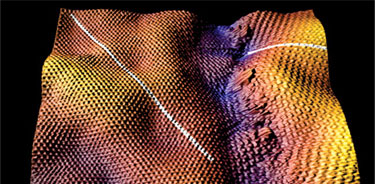The exceptional thermal conductivity of graphene drops by 20% compared with the pristine material, but only if its grain sizes are smaller than about 300–400 nm. This new result from researchers at the University of Illinois at Urbana-Champaign shows that polycrystalline graphene (such as that grown by chemical vapour deposition) with sufficiently large grains could still be employed in thermal management applications, like cooling down computer chips.

A grain boundary border
Previous research has shown that suspended pristine graphene can boast a thermal conductivity in the range of 2000–4000 Wm–1K–1 at room temperature – perhaps even higher than diamond, which is nature best heat conductor. The thermal conductivity of pristine graphene in contact with a SiO2 substrate also remains high at 600 Wm–1K–1, which is 50% higher than that of copper, widely used as a heat sink for computer chips.
However, graphene grown on the large scale is not typically pristine, but contains various imperfections, such as grain boundaries and line defects. “We wanted to find out how these individual grain boundaries and line defects affect heat flow in graphene, and whether such polycrystalline graphene can still be used as a superior heat conductor,” explained team member Andrey Serov.
Calculating graphene thermal properties
The researchers, led by Eric Pop, obtained their results by modelling the thermal conductance across grain boundaries and line defects in graphene using an atomistic simulation tool developed in their lab. In their method, atoms interact with each other as if connected by springs, with the spring constants dependent on the arrangement of the atoms in the material. The oscillations of the atoms create heat waves called phonons (vibrations of the crystal lattice) and by analysing how waves with different energy and polarization propagate through the lattice, the team was able to calculate the thermal properties of the graphene sheet.
Pop, Serov and team member Zhun-Yong Ong also found that “not all defects are created equal” in graphene. Although the material consists of carbon atoms arranged in a honeycomb lattice (as hexagons), lattice defects can appear as atoms arranged in pentagons, heptagons or octagons. “According to our calculations, octagons found in line defects appear to impede heat flow more drastically (by about 60% more) than pentagons and heptagons found in grain boundaries,” said Pop.
The results show that for CVD-graphene supported on SiO2 substrates (as would be the case in many applications), the heat flow is not significantly impeded for sufficiently large grains,” added Pop. “To exploit the high thermal conductivity of graphene for chip-cooling applications, for example, researchers should thus focus on eliminating all kinds of defects (holes, edge roughness and wrinkles) with a spacing smaller than about 300–400 nm,” he told nanotechweb.org.
The team says that it is now busy looking into thermal effects in graphene devices in which phonons travel ballistically – that is, without any collisions. Here, heat flow will be strongly affected by the edges of the graphene material or device.
"Another interesting aspect for us to explore is how graphene dissipates heat to its environment by interactions of its electrons with phonons in the underlying substrate,” said Serov. “This is important for better understanding and designing high-speed transistors, where heating plays an important role.
"We will also begin applying our simulation tools to other 2D materials, such as boron nitride,” he revealed.
The current work is detailed in Applied Physics Letters.

